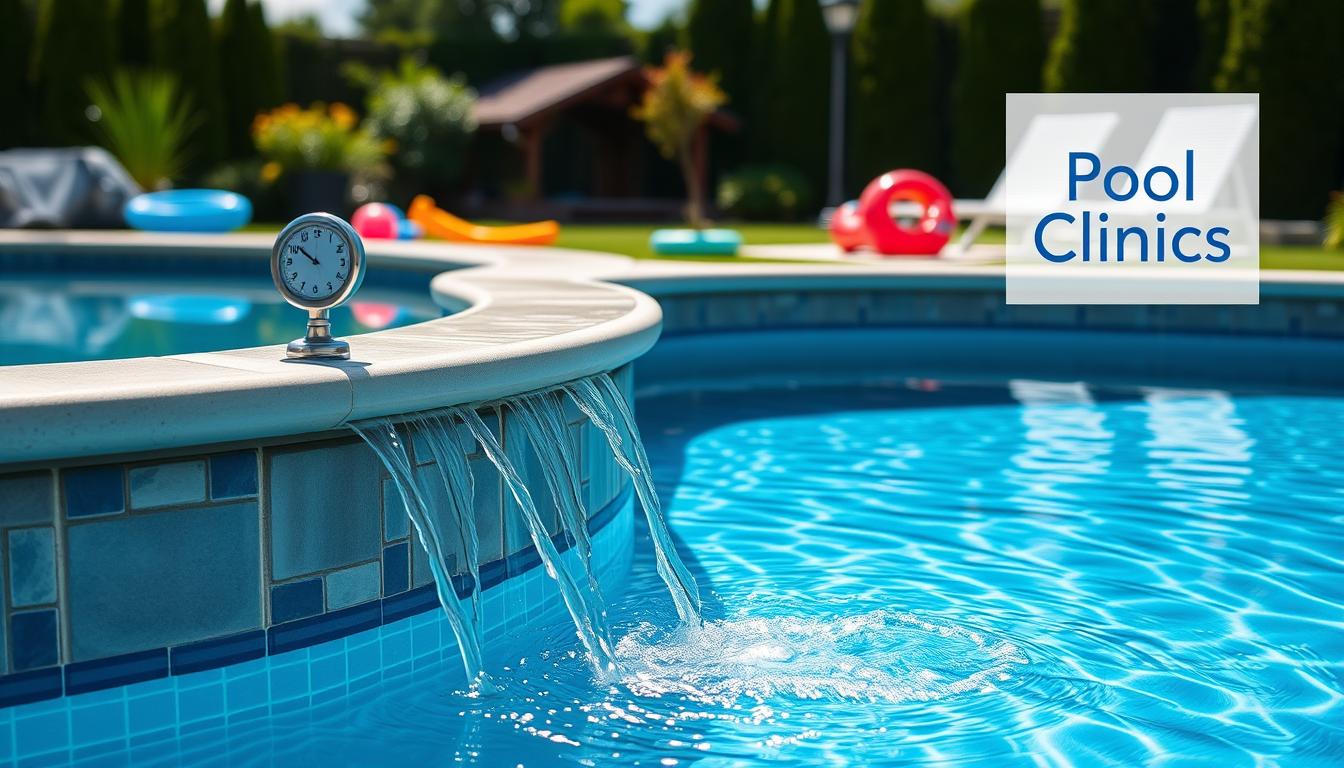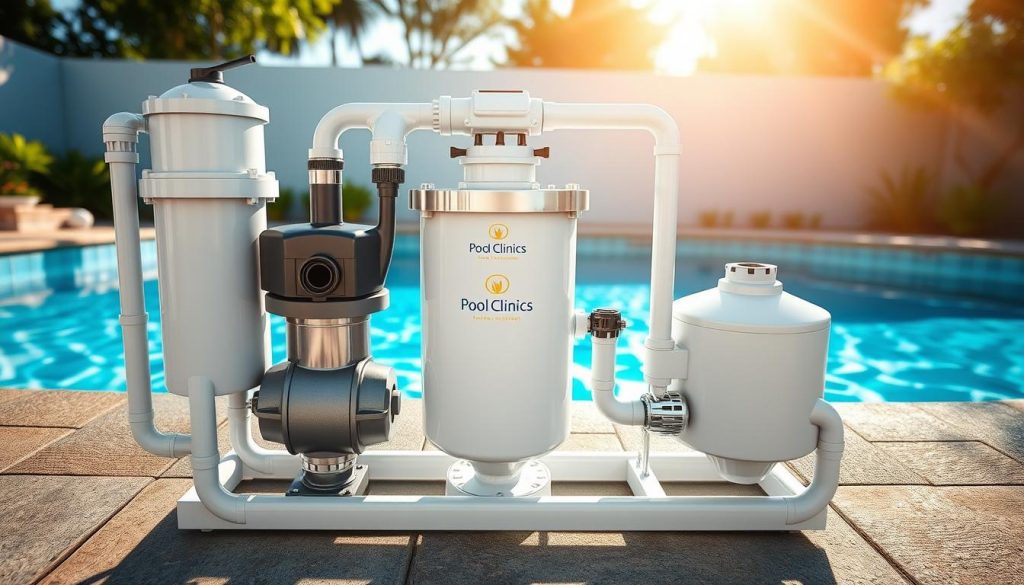
Every pool owner wants a clean, safe, and inviting backyard oasis. Draining and refilling your pool is crucial for maintenance. Experts suggest changing pool water every two to three years.
Several factors affect how often you should drain your specific pool. This guide will help you create a maintenance schedule for sparkling water. Your swimmers will be happy and safe.
Regular pool water replacement prevents contaminant buildup and ensures optimal water quality. Understanding your pool’s unique needs is key to proper maintenance. Following best practices will help you develop a tailored pool care routine.
This article offers valuable tips for maintaining a clean swimming environment. You’ll learn how to keep your pool healthy and enjoyable for years. Let’s explore the factors that influence pool draining frequency.
Key Takeaways
- Most pool experts recommend draining and refilling your pool every two to three years.
- Factors such as pool type, water quality, and seasonal changes can influence the optimal draining frequency for your pool.
- Regular water testing and monitoring of Total Dissolved Solids (TDS) levels can help you determine when it’s time to drain your pool.
- Saltwater pools generally require less frequent water changes compared to chlorine pools.
- Proper filtration, cleaning routines, and shock treatments can help maintain water quality and extend the time between pool draining.
Factors Influencing Pool Draining Frequency
Several factors affect how often you should drain your pool. Understanding these can help maintain water quality and ensure safe swimming. Proper maintenance leads to an enjoyable experience for all.

Pool Type and Maintenance Requirements
Your pool type influences draining frequency. Fiberglass pools resist algae growth, needing less cleaning. Concrete pools may need more frequent draining due to their porous surface.
Regular tasks like skimming and vacuuming help extend time between drainings. These keep the pool clean and well-maintained.
Water Quality and Chemical Balance
Proper water chemistry is crucial for a safe, clean pool. Hard water can lead to scale buildup and cloudy water. This affects filtration and may increase draining frequency.
Soft water, with lower mineral content, may require less frequent draining. Total dissolved solids (TDS) levels are another important factor.
High TDS levels make water cloudy and uncomfortable for swimmers. Regular shock treatments help manage TDS levels. Drain and refill when TDS exceeds 1,500-2,000 ppm.
Seasonal Changes and Weather Impact
Seasons and weather affect pool draining needs. Summer’s heavy use may require more frequent shock treatments. Heavy rain can dilute chemicals and introduce contaminants.
In freezing regions, drain the pool before winter closure. This prevents damage to the pool’s surface and equipment.
| Factor | Impact on Draining Frequency |
|---|---|
| Pool Type | Fiberglass: Less frequent; Concrete: More frequent |
| Water Hardness | Hard water: More frequent; Soft water: Less frequent |
| Total Dissolved Solids (TDS) | High TDS (>1,500-2,000 ppm): More frequent draining needed |
| Seasonal Changes | Summer: More frequent shock treatments; Winter: Proper draining before closing |
Signs Your Pool Needs Draining
Recognizing when to drain your pool is crucial for maintaining a clean swimming environment. By addressing issues promptly, you ensure a safe and enjoyable experience for everyone. Let’s explore key indicators that suggest it’s time to drain your pool.
Visible Debris and Cloudiness
Excessive debris in your pool, despite regular cleaning, may signal the need for draining. This includes leaves, twigs, and insects accumulating in the water. Cloudy or murky water that persists after using clarifiers could indicate a deeper problem.
In such cases, a complete water change might be necessary. This helps restore your pool’s clarity and cleanliness.
High Total Dissolved Solids (TDS) Levels
TDS levels are crucial to monitor in your pool water. They represent the concentration of dissolved materials like minerals and chemicals. High TDS can cause cloudy water and decreased chlorine efficiency.
When TDS exceeds 2,500 parts per million (ppm), it’s time to drain and refill. This action restores proper water balance and maintains optimal pool health.
| TDS Level (ppm) | Recommendation |
|---|---|
| Below 1,500 | Ideal range, no action needed |
| 1,500 – 2,000 | Acceptable, monitor closely |
| 2,000 – 2,500 | Consider partial draining and refilling |
| Above 2,500 | Drain and refill pool completely |
Persistent Algae Growth and Stains
Algae growth is a common pool problem, especially in warm and humid conditions. Regular chlorination usually keeps it at bay. However, persistent algae that resist treatment may require draining the pool.
Stubborn green, yellow, or black algae on pool surfaces can quickly become a problem. A complete water change may be necessary to effectively eliminate the issue.
If after a couple of days of continuously cleaning your pool and it’s still very cloudy and is still tinted green from the algae, it’s time to bring out the big guns. Use a flocculant to capture all of the tiny particles that are still clouding up your pool. Apply some algaecide and phosphate remover to stop algae blooms before they start.
Persistent stains on pool surfaces can also indicate the need for draining. These stains may come from metal buildup, organic matter, or chemical imbalances. If stain removal techniques fail, draining and thorough cleaning may be necessary.
How Often Should You Drain Your Pool?
Draining your pool is crucial for its health and longevity. The frequency depends on pool type, water quality, and environment. Let’s explore guidelines for different pools and the importance of water testing.
General Guidelines for Different Pool Types
Pool draining frequency varies by type. Vinyl pools need draining every 5-10 years for liner replacement. Cement or gunite pools require draining every 3-5 years for acid washing.
Fiberglass pools rarely need draining due to their algae and stain resistance. Above-ground pools may need more frequent draining, depending on water quality and upkeep.
When draining above-ground pools or draining in-ground pools, use proper equipment like a submersible pump and garden hoses. Open the hydrostatic valve and install hydrostatic plugs to prevent groundwater damage.
Importance of Regular Water Testing
Regular water testing helps determine when to drain your pool. Monitor chemical balance, total dissolved solids (TDS), and other water quality factors. This helps identify issues that may require draining.
| Water Quality Parameter | Ideal Range | When to Consider Draining |
|---|---|---|
| pH | 7.2-7.6 | If consistently out of range |
| Total Alkalinity | 80-120 ppm | If consistently out of range |
| Total Dissolved Solids (TDS) | Below 1,500 ppm | If above 2,500 ppm |
| Calcium Hardness | 200-400 ppm | If consistently out of range |
Consulting with Pool Professionals
If unsure about draining or water quality, consult a pool professional. They can assess your pool’s needs and offer advice on draining frequency and maintenance.
A professional pool service can help you develop a customized maintenance plan that takes into account your pool type, local climate, and water chemistry.
Follow these guidelines, test your pool water regularly, and seek expert advice when needed. This ensures your pool stays in top shape and is drained only when necessary.
Conclusion
Keeping your pool clean and safe is crucial for an enjoyable swim. Factors like pool type, water chemistry, and seasons affect draining frequency. Regular testing and monitoring help determine when to drain your pool.
Signs like high Total Dissolved Solids, persistent algae, and calcium buildup indicate draining time. Concrete pools need draining every 3-5 years, while vinyl and fiberglass pools last 5-7 years. However, adapt these guidelines to your pool’s specific needs.
Pool maintenance requires consistency and attention to detail. Address issues promptly to prevent bigger problems later. Consult pool professionals for valuable insights on proper care.
With regular upkeep, your pool will remain a source of joy and relaxation. Proper maintenance ensures years of refreshing fun for you and your loved ones.







